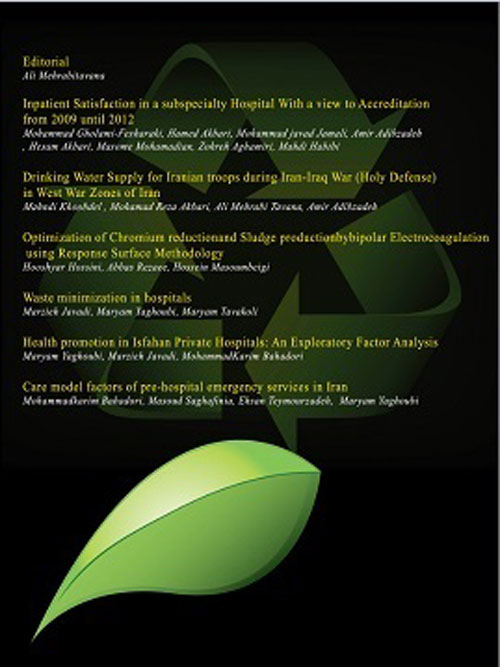Drinking Water Supply for Iranian troops during Iran-Iraq War (Holy Defense) in West War Zones of Iran
Author(s):
Abstract:
Introduction
Safe drinking water supply plays an important role in war zones, that is, emergency situations of military forces. Achieving this goal, choosing correct water resources (quantity), planning conservation and distribution systems along with disinfection as a minimum process for water treating (quality) are the essentials for the effective prevention of water-related contagious diseases and the elimination of potential pathogens in water. During most wars, safe water supply for military forces has been one of the worries of commanders, because lack of water or its contamination may cause interruption or failure. Methods
We performed this study through tracing the oral history narrated by 46 people who were the health personnel of Iran-Iraq war 1980-1988in west war zones. Documentation resources, health files and contents, dissertations and written reports were used to gather required information.Results
Drinking water during war operations in west war regions was safely supplied using these ways: 1000-18000 liter road tanks that moved along soldiers’ tracks usually were nightly filled up across safe regions like Mehran and Gilan-e-Gharb – compared to operation regions- and then chlorinated and disinfected by health technicians. As operation continued, big road tanks came from back lines and distributed water among smaller road tanks going to the front lines. There were bottles accompanying 10 to 15 chlorine tablets for each soldier whereby they could supply water out of springs and rivers along the route. Necessary educations were provided for the soldiers on chlorine tablets. In the last years of the war packed water was made up in addition to mineral water especially during chemical attacks. Because of Iraq chemical attacks and contamination of rivers, in some operations like Moslem-binaqeel (Apr 1982 in soomar district), 20 liter cruets were used in early stages of operation; The Cruets were put in back pack and were loaded by soldier. In the last stages, when operation progressed, small water road tanks 500 to 1200 liters) were used which had been filled, chlorinated and disinfected in Islamabad-e-Gharb prior to the war operation. Conclusion
Due to rough terrains of the Earth, impassable roads and in some cases loss of any path roads in the west, especially mountainous regions, water supply was brought via particular methods that most of them were innovative and peerless. Altogether, water supplies to soldiers during operations in the west war zones were almost decent, whether quantitatively or qualitatively.Keywords:
Water supply , Safe water , Military , Iran , Iraq
Language:
English
Published:
Journal of Health Policy and Sustainable Health, Volume:1 Issue: 1, Winter 2014
Pages:
7 to 11
magiran.com/p1399882
دانلود و مطالعه متن این مقاله با یکی از روشهای زیر امکان پذیر است:
اشتراک شخصی
با عضویت و پرداخت آنلاین حق اشتراک یکساله به مبلغ 1,390,000ريال میتوانید 70 عنوان مطلب دانلود کنید!
اشتراک سازمانی
به کتابخانه دانشگاه یا محل کار خود پیشنهاد کنید تا اشتراک سازمانی این پایگاه را برای دسترسی نامحدود همه کاربران به متن مطالب تهیه نمایند!
توجه!
- حق عضویت دریافتی صرف حمایت از نشریات عضو و نگهداری، تکمیل و توسعه مگیران میشود.
- پرداخت حق اشتراک و دانلود مقالات اجازه بازنشر آن در سایر رسانههای چاپی و دیجیتال را به کاربر نمیدهد.
In order to view content subscription is required
Personal subscription
Subscribe magiran.com for 70 € euros via PayPal and download 70 articles during a year.
Organization subscription
Please contact us to subscribe your university or library for unlimited access!


